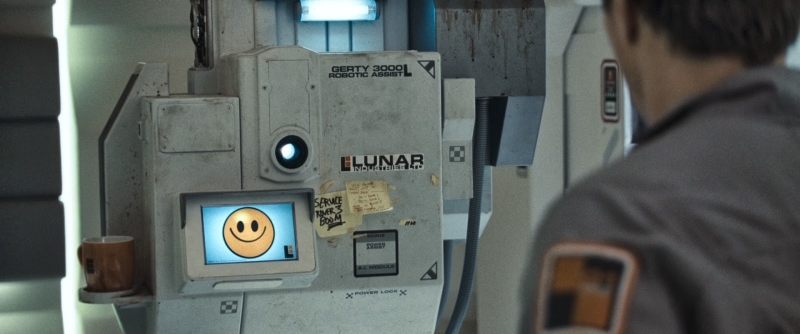IBM Watson, who has moved from “His game” to useful tasks like medicine, cooking art, or service tips, has finally reached the aerospace industry. And in the 21st century, the return of a person to the moon can occur under conditions when the AI will be a faithful adviser on the flight, the ship will land on the already prepared site with the base deployed by robots, and the telepresence robots will also become human functions.
 Interface II from the movie "Moon 2112"
Interface II from the movie "Moon 2112"Ibm watson
The latest
news - the cognitive system IBM Watson began to adapt to tasks in the field of aviation and astronautics. In this case, there are two types of tasks: “Research” and “Decision Making”. In the first case, the AI works as a scientific assistant, ready to submit the required information from a huge data bank. And the successful experience of answering questions formulated in natural language, shown in “Own game”, means that it will be possible to communicate quickly and effectively with such a scientific assistant.
The second option is even more interesting. In the "Decision Making" mode, the cognitive system becomes an adviser in the air traffic control center, the space control center, and even in the cabin of an airplane or spacecraft. The AI will receive a flow of data on the course of the flight and, armed with knowledge of technology, history of aviation and all relevant, will be able to give advice to pilots and flight managers. It is argued that as a test of the performance of the idea, a test has already been performed - the AI on the simulator filed a case of freezing of the aircraft’s measuring instruments. In a real flight, people gained and lost their height for twenty minutes, sorting out the situation, and IBM Watson successfully found the crash site and reported it. Work is currently underway to develop a cabin interface to integrate the system into the existing cockpit. Also IBM Watson is taught to understand more and radio communications.
 Monument to those killed in the crash of flight 301 Birgenair
Monument to those killed in the crash of flight 301 BirgenairWork with complex technical systems in aviation and astronautics vividly showed the shortcomings of human consciousness. People can be distracted, they can be easily confused and overloaded with information, especially under stress. Alas, the history of aviation knows cases when, due to the failure of instruments measuring flight parameters, pilots overloaded with conflicting emergency messages lost control of the aircraft and the situation that could be corrected ended in disaster. In the crash of flight
Aeroperú 603, the air pressure receiver on the commander’s side sealed during maintenance deprived him of airspeed data. If the pilots understood that one device was mistaken and switched to data from the co-pilot's LDPE, radio altimeter and gyro artificial horizon, they could return to the airport. Alas, because of the avalanche of alarm messages, they stopped believing all instruments at all and considered that the plane was not well controlled (which was not the case either). At night, over the sea, they lost their spatial orientation and, thinking that they were rising, smashed the plane against the water. In the crash of
flight 301 Birgenair, the clogged pitot tube (one of three!) Led to inaccurate airspeed readings on the commander's side. When warnings about flight speed (false) and dangerously low speed (real) without visual reference points (night and sea again) sounded in the cockpit, the crew was confused. The plane crashed on the water, all died. In both cases, an artificial intelligence system that would be able to identify the failed system and report on the indications of which instruments can be trusted could prevent a catastrophe.
Robonavty
Another developing theme is humanoid remote-controlled robots. The latest
news is that robot Fyodor will be used in all flight tests of the Federation ship, and not only in the first one, and may well have time to fly to the ISS together with people.
The benefits of such a robot is quite obvious. On the ISS, people are often used as “universal workers” who can change broken equipment, unload ships and perform other tasks that do not require either a creative approach or special qualifications. Remotely controlled "avatar", changing operators on Earth, can work for days and save astronauts time. In addition, it can be sent to dangerous places and used to eliminate the accident in the compartment where people cannot be. Since 2011, Robonaut, created by NASA and General Motors, has been working on the ISS. In 2014, he brought space legs.
 NASA Photos
NASA PhotosDespite the fact that work at the station is underway, sensations and breakthroughs are not yet noticeable. From the latest news - one robot is being
promoted at the Super Bowl 2017, and another instance
went to Australia for five years to work in the field of oil and gas production - turn valves and determine the leakage of gas.
All ready
However, the robot does not have to be humanoid in order to benefit. The idea of sending robots to the Moon or Mars first is obvious enough so that they prepare a landing site, build a base, and produce fuel for the return of people. A few years ago, at the European Space Agency, they
drew a concept robot with a 3D printer that will build a protective layer of the lunar base. One of the pretty recent
news is that a robot that can build a landing pad was tested in Hawaii.
 Photo: PISCES Center
Photo: PISCES CenterRobot Helelani was able to successfully collect more than a hundred tiles, for greater strength, connecting on the principle of a puzzle. It should be noted that the tiles are made of local material, basalt, not very different in composition from what will have to work on the Moon or Mars.
Conclusion
Space exploration is very different from the way the science fiction writers represented it. Instead of the pioneering heroes, cars go first, then, sometimes, animals, and only then people. This is not cowardice - it is foolish not to use the opportunities to get knowledge easier, cheaper and without graves, “over which black winds will sing legends about heroes”. At the same time, it is unlikely that humanity will turn into machines so much as to ignore the influence of space on people right now and not to study it, for example, on the ISS. Most likely, in the future, friends and colleagues will go to space - people, robots and artificial intelligence, complementing each other.